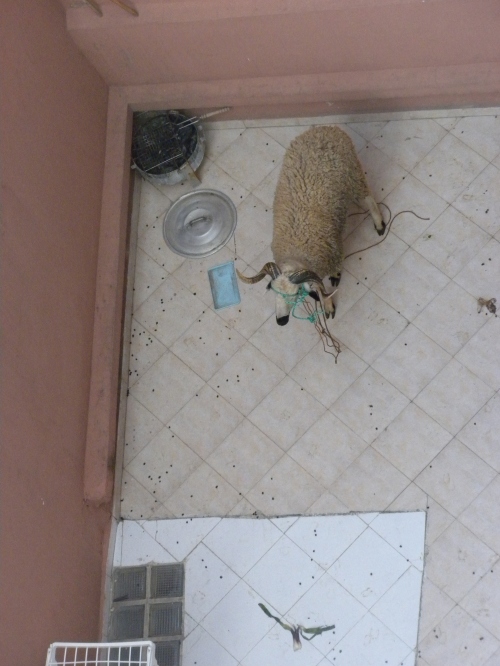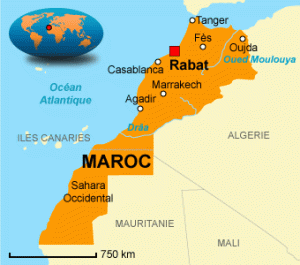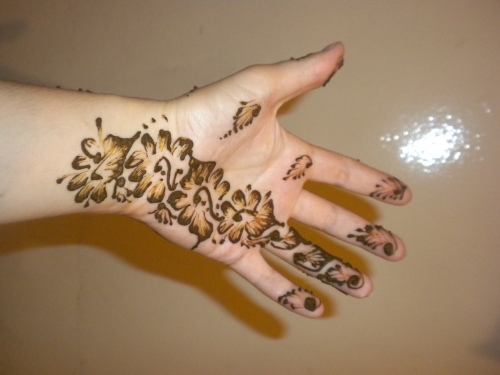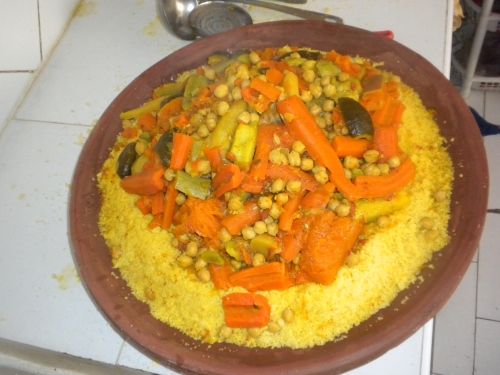Eid el-Adha is the holiday of sacrifice. Families each slaughter a sheep if they can afford it, and even if they can’t, as a sign of sacrifice to God. It’s also referred to as Eid el-Kabir, or the Big Eid, as opposed to the “small” one at the end of Ramadan. “Eid” simply means “holiday.”
Practitioners of Islam, Christianity, or Judaism might remember the story of Abraham, who was prepared to kill his own son as a sign of his complete trust in God. At the last possible moment, God asked him instead to sacrifice a sheep, and so here we are.
* * *
After morning prayers, my friend’s family came to pick me up at my apartment and take us all to my friend’s grandmother’s house. Everyone in the car, and in the street, was decked out in especially clean, if not new, jellabas, caftans, and at least in the case of and eight-year-old cousin of my friend’s, a sweet suit. I wore black pants and a button-down shirt—not too fancy, but clean at least. Right before lunch, I was urged to change into something “more comfortable,” which is how I ended up wearing an awesome purple caftan that my friend just up and gave to me at the end of the day.
What about the sheep?
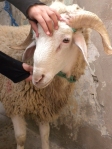 By 10:30, the three sheep on the rooftop terrace of the family’s house were very much alive. They had only been around for a week at most, but there was already the “nice” ones and the “mean” one. Later on, we could still tell which one was which by their heads.
By 10:30, the three sheep on the rooftop terrace of the family’s house were very much alive. They had only been around for a week at most, but there was already the “nice” ones and the “mean” one. Later on, we could still tell which one was which by their heads.
Islamic law in regards to halal butchering requires that animals be treated humanely leading up to their slaughter and in the way they are killed. As the first sheep was led away from the other two and the uncle/butcher checked the sharpness of his knife, a barrier was put up so that no sheep would witness the fate of the others.
The family washed the surface around the rooftop drain and prepared buckets and basins of water. The process of slaughter and butchering is messy, long, and very labor intensive for everyone.
I was around to take the obligatory picture of the first sheep right after his throat was slit, although I couldn’t watch the cut being made.
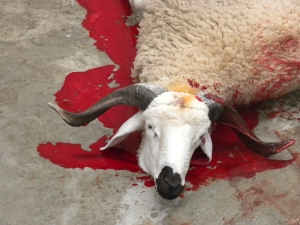
I only saw the next steps later in the day in videos taken by an aunt. The carcass is hung up, skinned, gutted, its intestines and organs washed, its limbs cut off.
In one video the uncle says, “She hardly saw anything at all!” And an aunt responds, “Maybe she’s too sensitive to watch the whole thing. Maybe. Mumkin.” I understood that last word clearly, but my friend translated the rest.
It was a little much for me. I’ve watched my grandma on her farm in France slaughter chickens and I was never really that into watching the entire process.
The first bites of the sheep were delicious. The liver was grilled, probably no more than a half hour after it came out of the animal. Then it was cubed, rubbed in cumin, wrapped in a strip taken from one of the sheets of fat that had been hung out to dry, and grilled once more. The resulting kabobs were super delicious, and I had two.

A half hour later, though, maybe under the effect of so much meat and fat at once, I was nauseous. The once kind-of-novel carcasses and severed body parts were suddenly very, very gross to me.
Eid in the streets
So I went on a walk with my friend through her grandma’s neighborhood to get some exercise and a little fresh air.
Well, not fresh air. Every other block or so, a group of guys were making a few Dirhams tending to a bonfire where neighbors came to have their sheep heads and legs roasted.

My friend suggested that the scene—closed shops, bonfires and smoke everywhere, the smell of burnt flesh—was like the set of a zombie movie. I hadn’t thought of that, but once she mentioned it… I guess you could say the neighborhood sort of resembled the friendliest post-apocalyptic city ever. There weren’t a lot of people in the streets, but the atmosphere was festive.
* * *
The blood and guts aspect of Eid el Kabir is almost impossible to gloss over or ignore, and it’s the number one thing I’ve heard from people about this holiday. This year was my first Eid el Kabir, and “blood in the streets”-wise, they weren’t exaggerating.
The slaughter is hugely important in this holiday, but so is spending time with family. I got to be adopted for a day as a hybrid honored guest/meskina clueless foreigner. Who is now the proud owner of a sweet purple caftan! Shoukran a Zainab!








